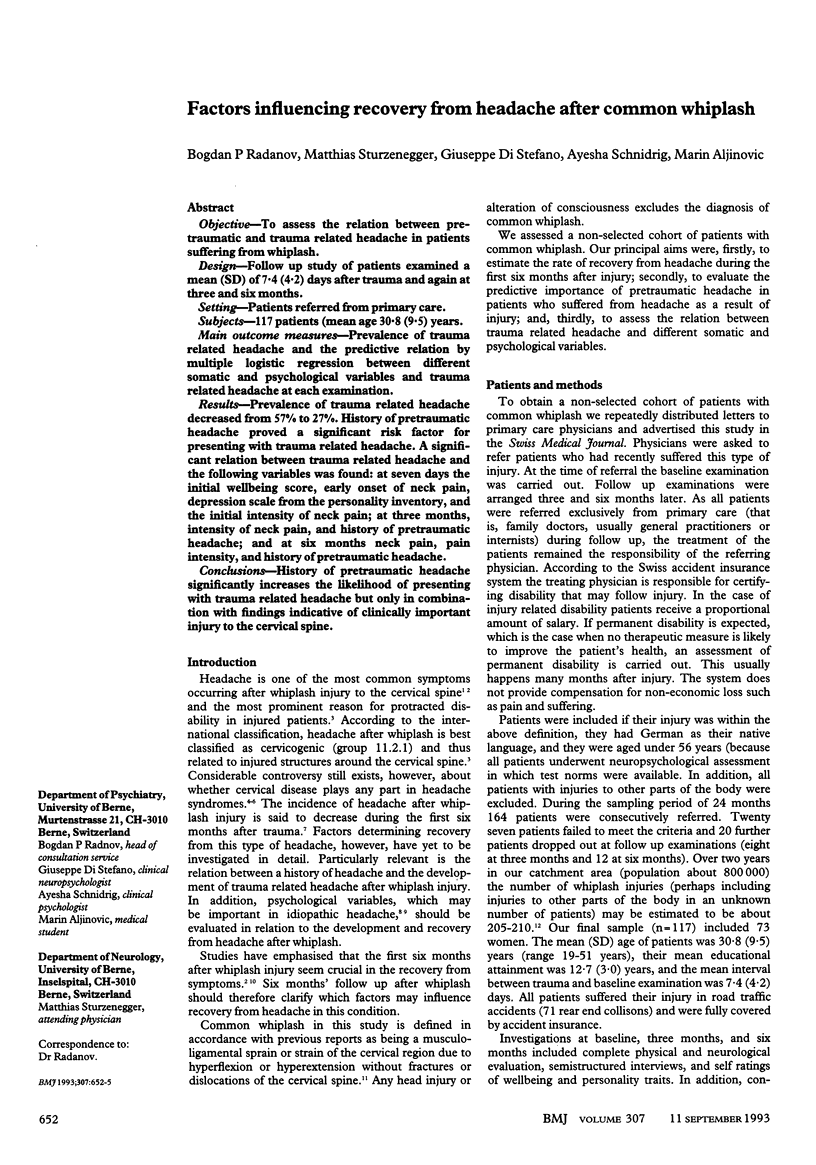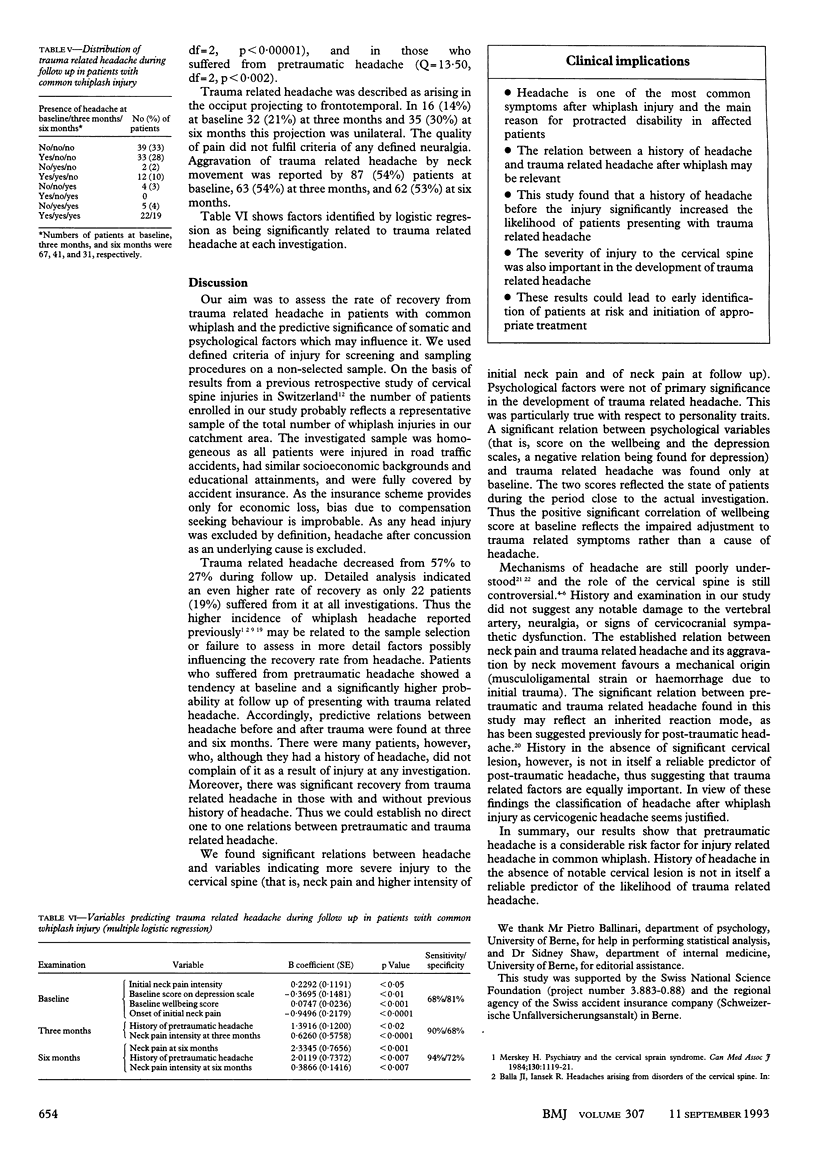Abstract
OBJECTIVE--To assess the relation between pretraumatic and trauma related headache in patients suffering from whiplash. DESIGN--Follow up study of patients examined a mean (SD) of 7.4 (4.2) days after trauma and again at three and six months. SETTING--Patients referred from primary care. SUBJECTS--117 patients (mean age 30.8 (9.5) years. MAIN OUTCOME MEASURES--Prevalence of trauma related headache and the predictive relation by multiple logistic regression between different somatic and psychological variables and trauma related headache at each examination. RESULTS--Prevalence of trauma related headache decreased from 57% to 27%. History of pretraumatic headache proved a significant risk factor for presenting with trauma related headache. A significant relation between trauma related headache and the following variables was found: at seven days the initial wellbeing score, early onset of neck pain, depression scale from the personality inventory, and the initial intensity of neck pain; at three months, intensity of neck pain, and history of pretraumatic headache; and at six months neck pain, pain intensity, and history of pretraumatic headache. CONCLUSIONS--History of pretraumatic headache significantly increases the likelihood of presenting with trauma related headache but only in combination with findings indicative of clinically important injury to the cervical spine.
Full text
PDF



Selected References
These references are in PubMed. This may not be the complete list of references from this article.
- Arena J. G., Blanchard E. B., Andrasik F. The role of affect in the etiology of chronic headache. J Psychosom Res. 1984;28(1):79–86. doi: 10.1016/0022-3999(84)90043-6. [DOI] [PubMed] [Google Scholar]
- Bellavance A., Belzile G., Bergeron Y., Huot J., Meloche J., Morand M. Cervical spine and headaches. Neurology. 1989 Sep;39(9):1269–1270. doi: 10.1212/wnl.39.9.1269. [DOI] [PubMed] [Google Scholar]
- Boquet J., Boismare F., Payenneville G., Leclerc D., Monnier J. C., Moore N. Lateralization of headache: possible role of an upper cervical trigger point. Cephalalgia. 1989 Mar;9(1):15–24. doi: 10.1046/j.1468-2982.1989.0901015.x. [DOI] [PubMed] [Google Scholar]
- Deans G. T., Magalliard J. N., Kerr M., Rutherford W. H. Neck sprain--a major cause of disability following car accidents. Injury. 1987 Jan;18(1):10–12. doi: 10.1016/0020-1383(87)90375-5. [DOI] [PubMed] [Google Scholar]
- Dvorak J., Valach L., Schmid S. Verletzungen der Halswirbelsäule in der Schweiz. Orthopade. 1987 Feb;16(1):2–12. [PubMed] [Google Scholar]
- Edmeads J. The cervical spine and headache. Neurology. 1988 Dec;38(12):1874–1878. doi: 10.1212/wnl.38.12.1874. [DOI] [PubMed] [Google Scholar]
- Hirsch S. A., Hirsch P. J., Hiramoto H., Weiss A. Whiplash syndrome. Fact or fiction? Orthop Clin North Am. 1988 Oct;19(4):791–795. [PubMed] [Google Scholar]
- Maimaris C., Barnes M. R., Allen M. J. 'Whiplash injuries' of the neck: a retrospective study. Injury. 1988 Nov;19(6):393–396. doi: 10.1016/0020-1383(88)90131-3. [DOI] [PubMed] [Google Scholar]
- Martin P. R., Marie G. V., Nathan P. R. Psychophysiological mechanisms of chronic headaches: investigation using pain induction and pain reduction procedures. J Psychosom Res. 1992 Feb;36(2):137–148. doi: 10.1016/0022-3999(92)90022-t. [DOI] [PubMed] [Google Scholar]
- Martin P. R., Nathan P. R., Milech D., van Keppel M. The relationship between headaches and mood. Behav Res Ther. 1988;26(4):353–356. doi: 10.1016/0005-7967(88)90090-3. [DOI] [PubMed] [Google Scholar]
- Merskey H. Psychiatry and the cervical sprain syndrome. Can Med Assoc J. 1984 May 1;130(9):1119–1121. [PMC free article] [PubMed] [Google Scholar]
- Norris S. H., Watt I. The prognosis of neck injuries resulting from rear-end vehicle collisions. J Bone Joint Surg Br. 1983 Nov;65(5):608–611. doi: 10.1302/0301-620X.65B5.6643566. [DOI] [PubMed] [Google Scholar]
- Pearce J. M. Whiplash injury: a reappraisal. J Neurol Neurosurg Psychiatry. 1989 Dec;52(12):1329–1331. doi: 10.1136/jnnp.52.12.1329. [DOI] [PMC free article] [PubMed] [Google Scholar]
- Radanov B. P., Dvorák J., Valach L. Cognitive deficits in patients after soft tissue injury of the cervical spine. Spine (Phila Pa 1976) 1992 Feb;17(2):127–131. doi: 10.1097/00007632-199202000-00001. [DOI] [PubMed] [Google Scholar]
- Watson D., Pennebaker J. W. Health complaints, stress, and distress: exploring the central role of negative affectivity. Psychol Rev. 1989 Apr;96(2):234–254. doi: 10.1037/0033-295x.96.2.234. [DOI] [PubMed] [Google Scholar]


